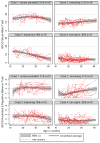Patterns of developmental trajectories in toddlers with autism spectrum disorder
- PMID: 22506796
- PMCID: PMC3365612
- DOI: 10.1037/a0027214
Patterns of developmental trajectories in toddlers with autism spectrum disorder
Abstract
Objective: Our objective was to follow toddlers referred for risk of autism, using standardized observational measures administered frequently from age 18 months to age 36 months.
Method: Sixty-five children who were consecutive referrals and 13 children from other research projects were seen approximately every 2 months, from age 18 months to age 36 months, for standardized assessments and clinical judgments by the same examiner and every 6 months by an examiner blind to previous scores.
Results: Thirty children never received an autism spectrum disorder (ASD) diagnosis; 48 children (all referrals) received at least 1 diagnosis of ASD. The best trajectory typology, using Autism Diagnostic Observation Schedule (ADOS) scores, revealed 4 trajectory classes with high probabilities for fit to the most likely class: severe persistent (21%), worsening (21%), improving (19%), and nonspectrum (40%). Classes differed by trajectories in verbal and nonverbal mental ages; never-ever ASD groups differed on Autism Diagnostic Interview-Revised (ADI-R) domain scores and clinician judgments, but improving-worsening trajectory groups did not.
Conclusions: The results replicated the findings from studies of infants whose siblings have autism and infants whose siblings do not have autism, suggesting variability in early trajectories and supporting the need for early identification, regular monitoring, and standardized assessments of young children suspected of having ASD.
Figures





References
-
- American Psychiatric Association. Diagnostic and statistical manual of mental disorders. 4. Washington, DC: Author; 1994.
-
- Anderson DK, Lord C, Risi S, Shulman C, Welch K, DiLavore PS, Pickles A. Patterns of growth in verbal abilities among children with autism spectrum disorder. Journal of Consulting and Clinical Psychology. 2007;75(4):594–604. - PubMed
-
- Baird G, Charman T, Pickles A, Chandler S, Loucas T, Meldrum D, Simonoff E. Regression, developmental trajectory and associated problems in disorders in the autism spectrum: The SNAP study. Journal of Autism and Developmental Disorders. 2008;38(10):1827–1836. - PubMed

